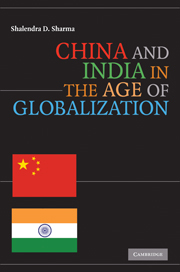Book contents
- Frontmatter
- Contents
- Acknowledgments
- Acronyms
- Political Map of China
- Political Map of India
- Introduction: China and India in the Age of Globalization
- 1 Prelude to Globalization: China (1949–1978) and India (1947–1991)
- 2 China and India Embrace Globalization
- 3 China: Strategies and Patterns of Global Integration
- 4 India: Strategies and Patterns of Global Integration
- 5 Sino-Indian Relations: Partners, Friends, or Rivals?
- 6 India and the United States: From Estrangement to Engagement
- 7 The Rise of China and Its Implications for the United States
- 8 China and India: Future Challenges and Opportunities
- Bibliography
- Index
3 - China: Strategies and Patterns of Global Integration
Published online by Cambridge University Press: 22 January 2010
- Frontmatter
- Contents
- Acknowledgments
- Acronyms
- Political Map of China
- Political Map of India
- Introduction: China and India in the Age of Globalization
- 1 Prelude to Globalization: China (1949–1978) and India (1947–1991)
- 2 China and India Embrace Globalization
- 3 China: Strategies and Patterns of Global Integration
- 4 India: Strategies and Patterns of Global Integration
- 5 Sino-Indian Relations: Partners, Friends, or Rivals?
- 6 India and the United States: From Estrangement to Engagement
- 7 The Rise of China and Its Implications for the United States
- 8 China and India: Future Challenges and Opportunities
- Bibliography
- Index
Summary
Over the past three decades, the Chinese economy has gradually but irrevocably moved away from central planning to a greater reliance on markets. Over this period, it has been the fastest growing economy in the world with real gross GDP growth rates averaging 9.5 percent per year during 1980–2004 and over 9 percent since 2005. Endowed with a GDP of $1.65 trillion, China is now the fourth largest economy in the world. If, as expected, China maintains its current growth trajectory it will become the world's largest economy by 2025, if not earlier (Organisation for Economic Co-operation and Development [OECD] 2005). Moreover, as Table 3.1 illustrates, the Chinese economy has undergone significant structural changes. The primary sector (agriculture, forestry, and fishing) has declined as a share of GDP, and the share in GDP of the secondary sector (comprising manufacturing and construction) contracted in the early 1990s as a result of the restructuring of the state-owned enterprises (SOEs) but has since recovered to about the same share in 2005 (47.5 percent) as in 1980 (48.2 percent). The tertiary sector covering service industries has dramatically expanded from 21.9 percent in 1980 to almost 40 percent in 2005.
The aim of this chapter is twofold: first, to elaborate some of the issues discussed in the preceding chapters – namely, how the reforms of the past three decades have affected China's political economy by delineating the outcomes (both the successes as well as the contradictions) and the socioeconomic and political implications of the reforms.
Information
- Type
- Chapter
- Information
- China and India in the Age of Globalization , pp. 91 - 130Publisher: Cambridge University PressPrint publication year: 2009
